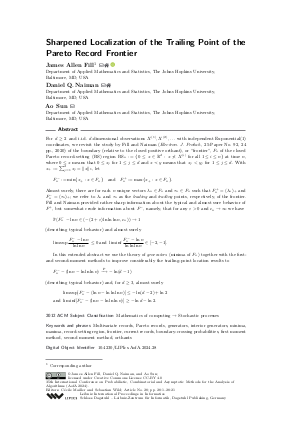Sharpened Localization of the Trailing Point of the Pareto Record Frontier
Authors
James Allen Fill  ,
Daniel Q. Naiman,
Ao Sun
,
Daniel Q. Naiman,
Ao Sun
-
Part of:
Volume:
35th International Conference on Probabilistic, Combinatorial and Asymptotic Methods for the Analysis of Algorithms (AofA 2024)
Part of: Series: Leibniz International Proceedings in Informatics (LIPIcs)
Part of: Conference: International Conference on Probabilistic, Combinatorial and Asymptotic Methods for the Analysis of Algorithms (AofA) - License:
 Creative Commons Attribution 4.0 International license
Creative Commons Attribution 4.0 International license
- Publication Date: 2024-07-18
File

PDF
LIPIcs.AofA.2024.28.pdf
- Filesize: 0.81 MB
- 21 pages
Document Identifiers
Related Versions
- Full Version https://arxiv.org/abs/2402.17221
Subject Classification
ACM Subject Classification
- Mathematics of computing → Stochastic processes
Keywords
- Multivariate records
- Pareto records
- generators
- interior generators
- minima
- maxima
- record-setting region
- frontier
- current records
- boundary-crossing probabilities
- first moment method
- second moment method
- orthants
Metrics
- Access Statistics
-
Total Accesses (updated on a weekly basis)
0PDF Downloads0Metadata Views
Abstract
For d ≥ 2 and i.i.d. d-dimensional observations X^{(1)}, X^{(2)}, … with independent Exponential(1) coordinates, we revisit the study by Fill and Naiman (Electron. J. Probab., 25:Paper No. 92, 24 pp., 2020) of the boundary (relative to the closed positive orthant), or "frontier", F_n of the closed Pareto record-setting (RS) region RS_n := {0 ≤ x ∈ R^d: x ⊀ X^(i) for all 1 ≤ i ≤ n} at time n, where 0 ≤ x means that 0 ≤ x_j for 1 ≤ j ≤ d and x ≺ y means that x_j < y_j for 1 ≤ j ≤ d. With x_+ : = ∑_{j = 1}^d x_j = ‖x‖₁, let
F_n^- := min{x_+: x ∈ F_n} and F_n^+ : = max{x_+: x ∈ F_n}.
Almost surely, there are for each n unique vectors λ_n ∈ F_n and τ_n ∈ F_n such that F_n^+ = (λ_n)_+ and F_n^- = (τ_n)_+; we refer to λ_n and τ_n as the leading and trailing points, respectively, of the frontier. Fill and Naiman provided rather sharp information about the typical and almost sure behavior of F^+, but somewhat crude information about F^-, namely, that for any ε > 0 and c_n → ∞ we have
P(F_n^- - ln n ∈ (- (2 + ε) ln ln ln n, c_n)) → 1
(describing typical behavior) and almost surely
limsup (F_n^- - ln n)/(ln ln n) ≤ 0 and liminf (F_n^- - ln n)/(ln ln ln n) ∈ [-2, -1].
In this extended abstract we use the theory of generators (minima of F_n) together with the first- and second-moment methods to improve considerably the trailing-point location results to
F_n^- - (ln n - ln ln ln n) ⟶P -ln(d - 1)
(describing typical behavior) and, for d ≥ 3, almost surely
limsup [F_n^- -(ln n - ln ln ln n)] ≤ -ln(d - 2) + ln 2
and liminf [F_n^- -(ln n - ln ln ln n)] ≥ -ln d - ln 2.
Cite As Get BibTex
James Allen Fill, Daniel Q. Naiman, and Ao Sun. Sharpened Localization of the Trailing Point of the Pareto Record Frontier. In 35th International Conference on Probabilistic, Combinatorial and Asymptotic Methods for the Analysis of Algorithms (AofA 2024). Leibniz International Proceedings in Informatics (LIPIcs), Volume 302, pp. 28:1-28:21, Schloss Dagstuhl – Leibniz-Zentrum für Informatik (2024)
https://doi.org/10.4230/LIPIcs.AofA.2024.28
BibTex
@InProceedings{fill_et_al:LIPIcs.AofA.2024.28,
author = {Fill, James Allen and Naiman, Daniel Q. and Sun, Ao},
title = {{Sharpened Localization of the Trailing Point of the Pareto Record Frontier}},
booktitle = {35th International Conference on Probabilistic, Combinatorial and Asymptotic Methods for the Analysis of Algorithms (AofA 2024)},
pages = {28:1--28:21},
series = {Leibniz International Proceedings in Informatics (LIPIcs)},
ISBN = {978-3-95977-329-4},
ISSN = {1868-8969},
year = {2024},
volume = {302},
editor = {Mailler, C\'{e}cile and Wild, Sebastian},
publisher = {Schloss Dagstuhl -- Leibniz-Zentrum f{\"u}r Informatik},
address = {Dagstuhl, Germany},
URL = {https://drops.dagstuhl.de/entities/document/10.4230/LIPIcs.AofA.2024.28},
URN = {urn:nbn:de:0030-drops-204631},
doi = {10.4230/LIPIcs.AofA.2024.28},
annote = {Keywords: Multivariate records, Pareto records, generators, interior generators, minima, maxima, record-setting region, frontier, current records, boundary-crossing probabilities, first moment method, second moment method, orthants}
}
Author Details
- Department of Applied Mathematics and Statistics, The Johns Hopkins University, Baltimore, MD, USA
- Department of Applied Mathematics and Statistics, The Johns Hopkins University, Baltimore, MD, USA
Funding
Research for all authors supported by the Acheson J. Duncan Fund for the Advancement of Research in Statistics.
Acknowledgements
We thank the anonymous reviewers for their helpful comments.
References
- Barry C. Arnold, N. Balakrishnan, and H. N. Nagaraja. Records. Wiley Series in Probability and Statistics: Probability and Statistics. John Wiley & Sons, Inc., New York, 1998. A Wiley-Interscience Publication. URL: https://doi.org/10.1002/9781118150412.
- Zhi-Dong Bai, Luc Devroye, Hsien-Kuei Hwang, and Tsung-Hsi Tsai. Maxima in hypercubes. Random Structures Algorithms, 27(3):290-309, 2005. URL: https://doi.org/10.1002/rsa.20053.
- Zhi-Dong Bai, Hsien-Kuei Hwang, Wen-Qi Liang, and Tsung-Hsi Tsai. Limit theorems for the number of maxima in random samples from planar regions. Electron. J. Probab., 6:no. 3, 41, 2001. URL: https://doi.org/10.1214/EJP.v6-76.
-
A.D. Barbour, Lars Holst, and Svante Janson. Poisson Approximation. Oxford studies in Probability. Oxford University Press, New York, 1992.

- James Allen Fill and Daniel Q. Naiman. Generating Pareto records, 2019. arXiv:1901.05621. URL: https://arxiv.org/abs/1901.05621.
- James Allen Fill and Daniel Q. Naiman. The Pareto record frontier. Electron. J. Probab., 25:Paper No. 92, 24, 2020. URL: https://doi.org/10.1214/20-ejp492.
-
J. Kiefer. Iterated logarithm analogues for sample quantiles when p_n↓ 0. Proceedings of the Sixth Berkeley Symposium on Mathematical Statistics and Probability (Univ. California, Berkeley, Calif., 1970/1971), Vol. I: Theory of statistics, pages 227-244, 1972.

- Daniel E. Loeb and Gian-Carlo Rota. Formal power series of logarithmic type. Adv. Math., 75(1):1-118, 1989. URL: https://doi.org/10.1016/0001-8708(89)90079-0.
- Steven Roman. The logarithmic binomial formula. Amer. Math. Monthly, 99(7):641-648, 1992. URL: https://doi.org/10.2307/2324994.
- J. Sesma. The Roman harmonic numbers revisited. J. Number Theory, 180:544-565, 2017. URL: https://doi.org/10.1016/j.jnt.2017.05.009.
